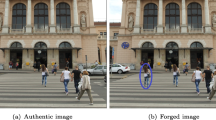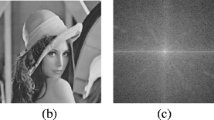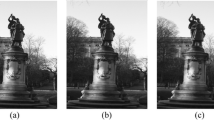Abstract
Median filtering has received considerable attention and popularity for image enhancement and anti-forensics. It can be utilized as an image denoising and smoothing tool to disguise the footprints of image processing operations such as image resampling and JPEG compression. A two-step median filtering anti-forensic framework is proposed in this paper to fool the existing median filtering forensic detectors by hiding the median filtering artifacts. In the proposed framework, a variational deconvolution approach is initially employed to generate a median filtered forgery. Now, this forgery is further processed in the second step by considering Total Variation (TV) based minimization optimization problem to eradicate the median filtering artifacts left during deconvolution operation. Moreover, the proposed TV-based minimization algorithms significantly reduce the unnatural (grainy) noise left during the variational deconvolution. Two types of TV-based minimization problems are suggested, first relies on the TV of energy by considering the image gradient and second on the structure of a given image. The performance of the proposed scheme is evaluated by considering the worst-case and optimal scenarios. The experimental results based on UCID and BOSSBase dataset images demonstrate that the proposed anti-forensic methods provide superior results in terms of image visual quality and forensic undetectability as compared to the existing approaches, with slight increase in computational time.









Similar content being viewed by others
Explore related subjects
Discover the latest articles, news and stories from top researchers in related subjects.References
Bas, P., Filler, T., & Pevny, T. (2011). Break our steganographic system: the ins and outs of organizing BOSS. In Proceedings of the international conference on information hiding (pp. 59–70).
Bayar, B., & Stamm, M. C. (2018). Constrained convolutional neural networks: A new approach towards general purpose image manipulation detection. IEEE Transactions on Information Forensics and Security, 13(11), 2691–2706.
Bertalmio, M., Vese, L., Sapiro, G., & Osher, S. (2003). Simultaneous structure and texture image inpainting. IEEE Transactions on Image Processing, 12(8), 882–889.
Bi, X., & Pun, C. M. (2017). Fast reflective offset-guided searching method for copy-move forgery detection. Information Science, 418, 531–545.
Bi, X., Pun, C. M., & Yuan, X. C. (2016). Multi-level dense descriptor and hierarchical feature matching for copy-move forgery detection. Information Science, 345, 226–242.
Böhme, R., & Kirchner, M. (2013). Counter-forensics: Attacking image forensics. In H. T. Sencar & N. Memon (Eds.), Digital image forensics (pp. 327–366). New York: Springer-Verlag.
Bovik, A. C. (1987). Streaking in median filtered images. IEEE Transactions on Acoustics, Speech, Signal Processing, 35(4), 493–503.
Cao, G., Zhao, Y., Ni, R., Yu, L., & Tian, H. (2010). Forensic detection of median filtering in digital images. In Proceedings of the IEEE international conference on multimedia expo (pp. 89–94).
Chang, C. C., & Lin, C. J. (2011). LIBSVM: A library for support vector machines. ACM Transactions on Intelligent Systems and Technology, 2(3). Art. ID 27.
Chen, C., & Ni, J. (2011). Median filtering detection using edge based prediction matrix. In Proceedings of the 10th international workshop on digital forensics and watermarking (pp. 361–375).
Chen, C., Ni, J., & Huang, J. (2013). Blind detection of median filtering in digital images: A difference domain based approach. IEEE Transactions on Image Processing, 22(12), 4699–4710.
Chen, C., Ni, J., Huang, R., & Huang, J. (2012). Blind median filtering detection using statistics in difference domain. In Proceeding of the 14th international conference on information hiding (pp. 1–15).
Chen, J., Kang, X., Liu, Y., & Wang, Z. J. (2015). Median filtering forensics based on convolutional neural networks. IEEE Signal Processing Letters, 22(11), 1849–1853.
Chen, Y., Lyu, Z., Kang, X., & Wang, Z. J. (2018). A rotation-invariant convolutional neural network for image enhancement forensics. In Proceedings of the IEEE international conference on acoustics, speech, and signal processing (pp. 2111–2115).
Dang-Nguyen, D. T., Gebru, I. D., Conotter, V., Boato, G., & De Natale, F. G. B. (2013). Counter-forensics of median filtering. In Proceeding of the IEEE 15th international workshop on multimedia signal processing (pp. 260–265).
Fan, W., Wang, K., Cayre, F., & Xiong, Z. (2013). JPEG anti-forensics using non-parametric DCT quantization noise estimation and natural image statistics. In Proceedings of the 1st ACM international workshop on information hiding and multimedia security (pp. 117–122).
Fan, W., Wang, K., Cayre, F., & Xiong, Z. (2013). A variational approach to JPEG anti-forensics. In Proceedings of the IEEE international conference on acoustics, speech, and signal processing (pp. 3058–3062).
Fan, W., Wang, K., Cayre, F., & Xiong, Z. (2015). Median filtered image quality enhancement and anti-forensics via variational deconvolution. IEEE Transactions on Information Forensics and Security, 10(5), 1076–1091.
Fan, Z., & de Queiroz, R. L. (2003). Identification of bitmap compression history: JPEG detection and quantizer estimation. IEEE Transactions on Image Processing, 12(2), 230–235.
Fontani, M., & Barni, M. (2012). Hiding traces of median filtering in digital images. In Proceeding of the 20th European signal processing conference (pp. 1239–1243).
Holub, V., & Fridrich, J. (2013). Digital image steganography using universal distortion. In Proceeding of the 1st ACM workshop on information hiding and multimedia security (pp. 59–68).
Kang, X., Stamm, M. C., Peng, A., & Liu, K. J. R. (2012). Robust median filtering forensics based on the autoregressive model of median filtered residual. In Proceedings of the Asia-Pacific signal and information processing association annual summit and conference (pp. 1–9).
Kang, X., Stamm, M. C., Peng, A., & Liu, K. J. R. (2013). Robust median filtering forensics using an autoregressive model. IEEE Transactions on Information Forensics and Security, 8(9), 1456–1468.
Kim, D., Jang, H., Mun, S., Choi, S., & Lee, H. (2018). Median filtered image restoration and anti-forensics using adversarial networks. IEEE Signal Processing Letters, 25(2), 278–282.
Kim, J. H., Akram, F., & Choi, K. N. (2017). Image denoising feedback framework using split Bregman approach. Expert Systems with Applications, 87, 252–266.
Kirchner, M., & Böhme, R. (2008). Hiding traces of resampling in digital images. IEEE Transactions on Information Forensics and Security, 3(4), 582–592.
Kirchner, M., & Fridrich, J. (2010). On detection of median filtering in digital images. In Proceedings SPIE (Vol. 7541, p. 754110).
Krishnan, D., & Fergus, R. (2009). Fast image deconvolution using hyper- Laplacian priors (pp. 1033–1041)., Advances in neural information processing systems Red Hook: Curran & Associates Inc.
Krishnan, D., Tay, T., & Fergus, R. (2011). Blind deconvolution using a normalized sparsity measure. In Proceedings of the IEEE conference on computer vision and pattern Recognition (pp. 233–240).
Levin, A., Weiss, Y., Durand, F., & Freeman, W. T. (2009). Understanding and evaluating blind deconvolution algorithms. In Proceedings of the IEEE conference on computer vision and pattern recognition (pp. 1964–1971).
Li, H., Luo, W., Qiu, X., & Huang, J. (2018). Identification of various image operations using residual-based features. IEEE Transaction on Circuits and Systems for Video Technology, 28(1), 31–45.
Liu, A., Zhao, Z., Zhang, C., & Su, Y. (2017). Median filtering forensics in digital images based on frequency-domain features. Multimedia Tools and Applications, 76(21), 22119–22132.
Peng, A., & Kang, X. (2012). Robust median filtering detection based on filtered residual. In Proceeding of the 11th international workshop on digital forensics and watermarking (pp. 344–357).
Pevný, T., Bas, P., & Fridrich, J. (2010). Steganalysis by subtractive pixel adjacency matrix. IEEE Transactions on Information Forensics and Security, 5(2), 215–224.
Pevny, T., Filler, T., & Bas, P. (2010). Using high-dimensional image models to perform highly undetectable steganography. In Proceedings of the international workshop on information hiding (pp. 161–177).
Pitas, I., & Venetsanopoulos, A. N. (1992). Order statistics in digital image processing. Proceedings of the IEEE, 80(12), 1893–1921.
Qin, C., Chang, C. C., Huang, Y. H., & Liao, L. T. (2013). An inpainting-assisted reversible steganographic scheme using a histogram shifting mechanism. IEEE Transactions on Circuits and Systems for Video Technology, 23(7), 1109–1118.
Qin, C., He, Z., Yao, H., Cao, F., & Gao, L. (2018). Visible watermark removal scheme based on reversible data hiding and image inpainting. Signal Processing: Image Communication, 60, 160–172.
Redi, J. A., & Dugelay, J. L. (2011). Digital image forensics: A booklet for beginners. Multimedia Tools and Applications, 51(1), 133–162.
Schaefer, G., & Stich, M. (2003). UCID: An uncompressed color image database. Proceeding of SPIE, 5307, 472–480.
Singh, G., & Singh, K. (2017). Improved JPEG anti-forensics with better image visual quality and forensic undetectability. Forensic Science International, 277, 133–147.
Singh, G., & Singh, K. (2018). Forensics for partially double compressed doctored JPEG images. Multimedia Tools and Applications, 77(1), 485–502.
Stamm, M. C., & Liu, K. J. R. (2011). Anti-forensics of digital image compression. IEEE Transactions on Information Forensics and Security, 6(3), 1050–1065.
Vapnik, V. (2013). The nature of statistical learning theory. New York: Springer.
Wang, D., Gao, T., & Yang, F. (2018). A forensic algorithm against median filtering based on coefficients of image blocks in frequency domain. Multimedia Tools and Applications, 77(18), 23411–23427.
Wang, W., Zhao, X., & Ng, M. (2016). A cartoon-plus-texture image decomposition model for blind deconvolution. Multidimensional Systems and Signal Processing, 27(2), 541–562.
Wu, Z.-H., Stamm, M. C., & Liu, K. J. R. (2013). Anti-forensics of median filtering. In Proceedings of the IEEE international conference on acoustics, speech, and signal processing (pp. 3043–3047).
You, Y. L., Xu, W., & Tannenaum, A. (1996). Behavioral analysis of anisotropic diffusions in image processing. IEEE Transactions on Image Processing, 5(11), 1539–1553.
Yu, S., Moon, B., Kim, D., Kim, S., Choe, W., Lee, S., et al. (2017). Continuous digital zooming of asymmetric dual camera images using registration and variational image restoration. Multidimensional Systems and Signal Processing, 1–29.
Yuan, H.-D. (2011). Blind forensics of median filtering in digital images. IEEE Transactions on Information Forensics and Security, 6(4), 1335–1345.
Zeng, H., Kang, X., & Peng, A. (2016). A Multi-purpose countermeasure against image anti-forensics using autoregressive model. Neurocomputing, 189, 117–122.
Zhang, Y., Li, S., Wang, S., & Shi, Y. Q. (2014). Revealing the traces of median filtering using high-order local ternary patterns. IEEE Signal Processing Letters, 21(3), 275–279.
Zhang, Y. S., Zhang, F., & Li, B. Z. (2018). Image restoration method based on fractional variable order differential. Multidimensional Systems and Signal Processing, 29(3), 999–1024.
Acknowledgements
This work was supported by Visvesvaraya PHD scheme for Electronics and IT, Ministry of Electronics and Information Technology, Government of India (Grant PhD-MLA/4(33)/2015-16/01).
Author information
Authors and Affiliations
Corresponding author
Additional information
Publisher’s Note
Springer Nature remains neutral with regard to jurisdictional claims in published maps and institutional affiliations
Rights and permissions
About this article
Cite this article
Singh, K., Kansal, A. & Singh, G. An improved median filtering anti-forensics with better image quality and forensic undetectability. Multidim Syst Sign Process 30, 1951–1974 (2019). https://doi.org/10.1007/s11045-019-00637-8
Received:
Revised:
Accepted:
Published:
Issue Date:
DOI: https://doi.org/10.1007/s11045-019-00637-8




